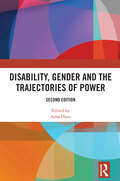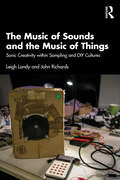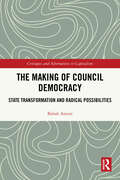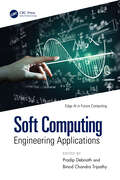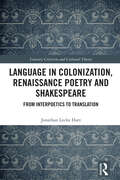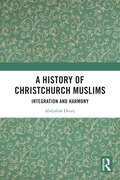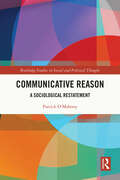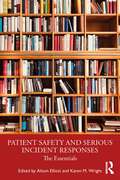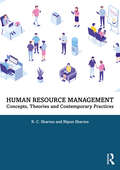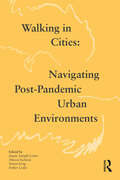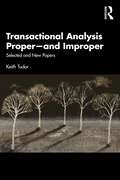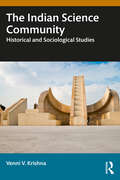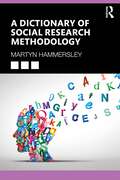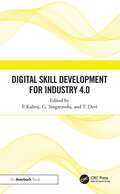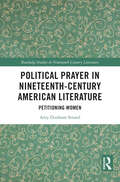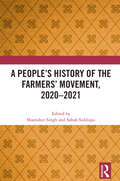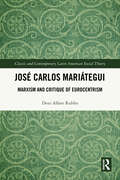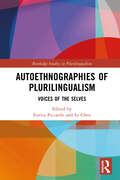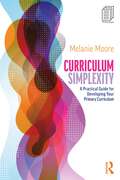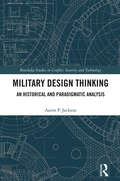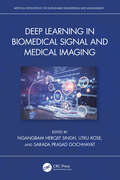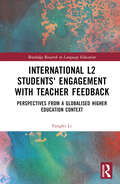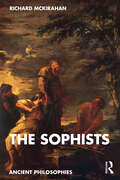- Table View
- List View
Disability, Gender and the Trajectories of Power
by Asha HansThis book explores the gendered experience of disability. It investigates how women with disabilities fare in society focusing on the experiences of women and their interactions with family, society and medical and legal institutions.Women with disabilities face unprecedented levels of violence, oppression and marginalisation in their daily lives as well as a lack of visibility, proper care and opportunities for socio-economic development. This book examines the reasons and consequences of the stigmatisation of disabilities and neurodivergence, denial of proper care, and various forms of exclusion and violence women with disabilities face both within and outside of their homes. It brings together the perspectives of academicians and activists that try and understand the various challenges faced by women with disabilities and highlights the fight for their right to autonomy, respect, equality, and justice. Filling the gap in the existing feminist research, this revised edition seeks to influence the way in which society treats women with disabilities and will be of interest to scholars and researchers in the field of women’s rights, disability rights, rehabilitation, social policy, and the body.
The Music of Sounds and the Music of Things: Sonic Creativity Within Sampling and DIY Cultures
by Leigh Landy John RichardsThis book investigates two areas in which the appreciation of sonic creativity can be easily acquired across diverse cultures, ages and interests: the music of sounds – making music with any sounds, part of today’s sampling culture and the music of things – and the creation of instruments using existent materials (another type of sampling?) involving the notion of ‘instrument as composition’ as part of today’s DIY (or DIT, do it together) culture.The book offers broad discussions regarding the music of things (written by John Richards) followed by the music of sounds (written by Leigh Landy). These chapters are followed by a focus on the workshop demonstrating the collaborative and inclusive potential in both areas, and a spotlight on eight artists with a broad diversity of backgrounds and approaches to sound and music who discuss their perceptions. The book’s conclusion focuses on similarities and differences between the music of sounds and the music of things, suggesting, finally, that both might form part of the 21st- century’s folk music landscape.The book is primarily aimed towards students interested in current forms of sonic creativity but will be of interest to those interested in broader issues of sampling culture, hacking and sound studies.
The Making of Council Democracy: State Transformation and Radical Possibilities (Critiques and Alternatives to Capitalism)
by Babak Amini“Council democracy” is a particular form of democratic socialism that strives towards democratic self-governance on the basis of active, free, and associated individuals working cooperatively within a federated council system. Both in political practice and in social theory, “council democracy” has resurfaced periodically in the past, most notably in the interwar period, in the “long 1960s,” and since the turn of the 21st century. This book offers a novel theoretical and methodological approach to the study of “council democracy.” It focuses on the processes that led to the emergence of two of the foundational and most radical instances of “council democratic” movements in Germany during the German Revolution (1918-1919) and in Italy during the biennio rosso (1919-1920). With all their diversities, ambiguities, and shortcomings, these movements, in varying degrees, sought democratic alternatives to autocratic relations, from local to state levels, and to economic relations, from workplace to national levels. The book shows how the processes through which state-led war mobilization transformed the contours of class struggle laid the ground for the emergence of “council democratic” movements with specific characteristics in Germany and Italy and not in the United Kingdom and France.
Soft Computing: Engineering Applications (ISSN)
by Pradip Debnath Binod Chandra TripathyThis book examines the latest developments in the area of soft computing with engineering applications. It explores topics such as fuzzy sets, intuitionistic fuzzy sets, unmanned aerial vehicles, soft sets, neutrosophic sets, fractional calculus, big data analytics, and the mathematical foundations of convolutional neural network (CNNs). Soft Computing: Engineering Applications offers readers a comprehensive and in-depth understanding of various cutting-edge technologies that are transforming industries worldwide. The book explores soft computing techniques in a very systematic manner. It elucidates the concepts, theories, and applications of fuzzy sets, enabling readers to grasp the fundamentals and explore their applications in various fields. It provides new insight into unmanned aerial vehicle applications to fuzzy soft set based decision making. It then discusses new fixed point results in orthogonal neutrosophic generalized metric spaces and explores statistical convergence of triple sequences in a credibility space. The authors then provide readers with a solid grasp of the mathematical underpinnings of CNNs, enabling them to design, train, and optimize neural networks for image recognition, object detection, and other computer vision tasks. The authors also present new studies in fractional calculus and explores advanced visualization algorithms and techniques for big data analytics.Soft Computing will be useful for beginners and advanced researchers in engineering, applied sciences and healthcare professionals working in soft computing applications.
Language in Colonization, Renaissance Poetry and Shakespeare: From Interpoetics to Translation (Literary Criticism and Cultural Theory)
by Jonathan Locke HartLanguage is the central concern of this book. Colonization, poetry and Shakespeare – and the Renaissance itself – provide the examples. I concentrate on text in context, close reading, interpretation, interpoetics and translation with particular instances and works, examining matters of interpoetics in Renaissance poetry and prose, including epic, and the Hugo translation of Shakespeare in France and trying to bring together analysis that shows how important language is in the age of European expansion and in the Renaissance. I provide close analysis of aspects of colonization, front matter (paratext) in poetry and prose, and Shakespeare that deserve more attention. The main themes and objectives of this book are an exploration of language in European colonial texts of the “New World,” paratexts or front matter, Renaissance poetry and Shakespeare through close reading, including interpoetics (liminality), translation and key words.
A History of Christchurch Muslims: Integration and Harmony
by Abdullah DruryThis book examines a significant part of New Zealand history through a critical analysis of the Muslim community in Christchurch, a neglected but important aspect of wider New Zealand social and religious history.Islam is one of the fastest growing religions in New Zealand and one of the least understood by the wider public. However, the historic reality demonstrates that the first Muslim settlers arrived within 15 years of the proclamation of the colony in 1841, and many have been living quietly in this country and contributing to society ever since. Drury elucidates how New Zealand Muslims have proved it possible to integrate into a European society in the South Pacific whilst retaining an idiosyncratic sense of Islamic communal identity.This book is a useful reference for scholars and educators curious to learn more about Muslims in New Zealand and about the Christchurch Mosque communities before the 2019 shootings.
Communicative Reason: A Sociological Restatement (Routledge Studies in Social and Political Thought)
by Patrick O'MahonyThe book examines philosophical and sociological approaches within critical theory and more widely from the vantage point of communicative reason. It seeks to revitalize the sociological dimension of critical theory by advancing a critical sociology of reason. It does so fully in the knowledge that reason is a contentious concept in sociology and other disciplines. Nonetheless, building on Habermas’s original insight, it argues that an extensively modified version of communicative reason is indispensable. This modified approach will draw extensively from Peirce’s pragmatist semiotics and critical cognitive sociology. Such a focus has significant implications for meta-theoretical, theoretical-empirical, and methodological approaches in critical theory, critical sociology, and related disciplines. This book will be of interest to readers in the social sciences, humanities, and philosophy who value the importance of a social theory of a reasonable society for their disciplines and for increasingly essential interdisciplinary activities. The book will also appeal to many in critical theory and beyond who are interested in the cognitive foundations of normative orders, including unjust or pathological as well as actually or potentially just foundations. The book emphasizes both validity and critique within communicative reason and critical theory and accordingly presents a distinctive perspective on critical-reconstructive research.
Patient Safety and Serious Incident Responses: The Essentials
by Alison Elliott Karen M. WrightThis step-by-step guide takes the reader through the complex process of investigating serious incidents in health, social care, and criminal justice environments, acknowledging differences of culture and context that shape an investigation. Taking a multi-disciplinary approach, Part 1 begins by exploring the key principles of investigation, including ethical and legal perspectives, the involvement of families and carers, and being aware of unconscious bias, among other issues. Part 2 outlines in detail the conduct of investigations, from planning to processing the findings, before moving on to Part 3, carrying them out in diverse settings. Further chapters then look at investigating within diverse environments before moving on to to Part 4 which deals with reviewing and analysing the evidence collected and writing up the investigation. This final part also examines the pivotal issue of learning from the investigation and disseminating the report. The inclusion of case studies, models of good practice, and vignettes enables the reader to view each stage of the process in context and drive the transformation of practice. This practical resource is designed to support health and social care professionals who undertake investigations as part of their role, including nurses, allied health practitioners, social workers, doctors, and psychologists, as well as military personnel and law enforcers. It is an essential companion.
Human Resource Management: Concepts, Theories, and Contemporary Practices
by R. C. Sharma Nipun SharmaThis textbook introduces readers to an array of concepts and current practices of human resource management (HRM). It provides an understanding of the current problems in the area that require pragmatic research and realistic solutions.Using a blend of diverse concepts, theories, tools and techniques, the book discusses contemporary practices of HRM and the challenges related to acquiring and training people, human resource development, compensation and reward, employee relations, technological changes, HR records, audit, research and more. Supported by the authors’ rich experience of over five decades in academics as well as in the corporate sector and case studies, the book will enhance conceptual understanding of HRM, throw light on recent developments in this subject area and offer management strategies for problems and challenges related to human resources.This book will be an essential textbook for students, professionals, corporate trainers and researchers of business studies, management studies, marketing, human resource management, resource management, work and organisational psychology, human resource development, risk management, economics and finance.
Walking in Cities: Navigating Post-Pandemic Urban Environments
by Jaspar Joseph-Lester Ahuvia Kahane Simon King Esther LeslieThis book brings together an international group of artists and writers to respond to the question of how our new world orders force us to reconsider urban walking and urban spaces in ways which extend into the digital sphere of online dialogue and screen sharing. In their reflections on walking cities in lockdown, the artists and writers contributing to this book share a number of complementary themes. Key to this is the question of how we walk in post-pandemic cities and how such walking might motivate or be motivated by transgressive, atomised or collective thoughts, affects, relations and experiences. Here we see how navigating cities in lockdown requires us to re-territorialise, improvise, create and de- or re-politize. There is, for example, a clear distinction between the severe lockdown measures that were introduced in Cape Town and the liberal appeal to good citizenship that northern hemisphere cities such as Stockholm chose to rely on. These measures impact on the way we experience urban walking and, in each case, lead to deeper reflections about the heightened presence of ideological structures embedded within the urban.
Transactional Analysis Proper—and Improper: Selected and New Papers
by Keith TudorTransactional Analysis Proper—and Improper: Selected and New Papers offers a critical reading of transactional analysis (TA), which analyses, deconstructs, and reconstructs its foundational theory.Keith Tudor’s work is detailed, informative, and critical, and written with deep affection for TA and its founder, Eric Berne. Beginning with its philosophical foundations, Tudor considers TA’s ontological assumptions about the essence of human beings, its method and methodology, and its treatment philosophy. A series of chapters then review and advance TA’s theory of transactions, ego states, life scripts, and psychological games, and the book concludes with two chapters which both honor TA’s traditions and look forward to what TA might do differently.This book offers a unique ‘insider but independent’ perspective on transactional analysis. It will be essential reading for students and practitioners of transactional analysis and encourages free, independent, and critical thinking about TA and its place in the world.
Bioelectrochemical Oxidation Processes for Wastewater Treatment
by Maulin P. ShahToxic and hazardous pollutant treatment of wastewater is a longstanding challenge faced in every region across the globe. Growing urbanization, combined with the increased use of detergent soaps, cleansing agents with new formulations, chemical fertilizers, and pesticides, has greatly added to the global wastewater pollution burden. Conventional methods of wastewater treatment are somewhat successful in decontamination, but these current techniques require more time and energy than newer, novel techniques. Bioelectrochemical oxidation systems (BEOSs), for example, have greatly aided in wastewater treatment sustainability and efficiency, and offer promising solutions for different types of energy recovery options. Bioelectrochemical Oxidation Processes for Wastewater Treatment examines the latest hybrid technologies utilizing algae, bacteria, and various other chemical agents, and discusses the major challenges in large-scale operations, as well as forward-looking techniques to make treatment processes even more sustainable in the future. It: Discusses the fundamentals of biological wastewater treatment and bioelectrochemical oxidation systems, as well as their advantages and limitations. Presents the recent trends and developments in bioelectrochemical oxidation systems for achieving environmentally sustainable wastewater treatment. Describes carbon capture and resource recovery from wastewater using bioelectrochemical oxidation systems. Addresses the challenges of large-scale implementation of bioelectrochemical oxidation systems in existing and new wastewater treatment plants.
The Indian Science Community: Historical and Sociological Studies
by Venni V. KrishnaThis book focuses on the historical and sociological dimensions of scientists working in laboratories in India, offering insights into the historical, sociological and policy factors that shape scientific pursuits. It illuminates the challenges, accomplishments and the evolving role of science in societal development.The author initiates a broader discourse on the interplay between scientific advancements, societal contexts and policy frameworks. The book fosters a deeper understanding of science's role in shaping India’s social fabric and contributing to the global scientific dialogue. It also explores issues such as brain drain, science activism and the conflict between university- and government-run models of science.Lucid and topical, the book will be of considerable interest to both social and natural scientists, as well as the general academic community, including research students in science, technology, history, social history of science, science and technology studies and innovation policies.
A Dictionary of Social Research Methodology
by Martyn HammersleyThis accessible book offers a detailed guide to a wide range of methodological concepts, both those of a philosophical kind and those that are more technical in character: from constructionism to critical realism, grounded theory to regression analysis, odds ratios to triangulation.It covers quantitative, qualitative, and mixed methods research. There are shorter entries for relatively straightforward terms and longer entries for terms that are more complex or carry more than one meaning. The book includes basic terms – such as data, empirical, fact, meaning, theory, and truth – as well as those that highlight major contemporary trends in the field, such as arts-based research, indigenous methodologies, and decolonisation. It is therefore relevant to many methodological issues and controversies taught in social science degree programmes today.Providing clear definitions for a wide range of methodological concepts from across the social sciences, this is an essential resource for all who have an interest in social research methodology.
Digital Skill Development for Industry 4.0
by P. Kaliraj G. Singaravelu T. DeviThe Fourth Industrial Revolution, Industry 4.0, is changing the world, and digital transformation technology tools have impacted every walk of life. The nature of work and careers is changing fast – and in the future, the right skills will be prized over academic qualifications. Students must develop various skills, especially technology skills, to become the workforce of the future; the onus of developing these skills falls on educational institutions. The development of innovation and ideation skills in students is a must for them to productively contribute to a future economy. They should have the capability to translate ideas into solutions, products, and systems that are scalable, practically feasible, and adaptable.To prepare students for this digital world, Digital Skill Development for Industry 4.0 contains chapters on developing: Professional skills, cognitive learning Critical thinking skills among modern learners Motivation and student engagement Invoking interest of students Student engagement in e-learning Contextual learning Experimental learning Multidisciplinary learning The book is written for the academic and administrative community of universities and colleges who intend to equip their modern learners with the skills of Industry 4.0. It is also useful as a reference for undergraduate and postgraduate courses, as well as doctoral programs. The book can also serve as a comprehensive reference guide for researchers in the development of tools incorporating new skills and technologies. Practitioners who are interested in introducing digital skill development for Industry 4.0 and its tools to solve real‑world problems can also use this book.
Political Prayer in Nineteenth-Century American Literature: Petitioning Women (Routledge Studies in Nineteenth Century Literature)
by Amy Dunham StrandPolitical Prayer in Nineteenth-Century American Literature explores how American women writers such as Catharine Maria Sedgwick, Harriet Beecher Stowe, Rebecca Harding Davis, and Emily Dickinson translated petitioning – a political form for redress of grievances with religious resonance, or what Strand calls “political prayer” – in their literary works. At a time when petitioning was historically transforming governments, mobilizing masses, and democratizing North America, these White women writers wrote “literary petitions” to advocate for others in social justice causes such as antiremoval, antislavery, and labor reform, to transform American literature and culture, and to articulate an ambivalent political agency. Political Prayer in Nineteenth-Century American Literature introduces historic petitioning into literary study as an overlooked but important new lens for reading nineteenth-century fiction and poetry. Understanding petitions in these literary works – and these literary works as petitions – also helps us to understand women’s political agency before their enfranchisement, to explain why scholars have long debated and inconsistently interpreted the works of well-anthologized women writers, and to see more clearly the multidimensional, coexisting, and often competing religious and political aspects of their writings.
A People's History of the Farmers' Movement, 2020–2021
by Shamsher Singh Sabah SiddiquiIn the annals of India’s history, a monumental uprising unfolded in 2020, echoing the resilience and coming together of large sections of its agrarian base. Instigated by the contentious farm laws of 2020, the Farmers’ Movement burgeoned into a year-long saga of protest and perseverance, ending only in December 2021 after the passing of the Farm Laws Repeal Bill, 2021 by the Indian Parliament. From the initial demand for law repeal to the multifaceted growth of the movement, the book traces the journey of the Farmers’ Movement, as each essay dissects the socio-political dynamics, cultural nuances, and mass solidarity that underpinned the protests, including focused analyses from Delhi, Punjab, Haryana, Uttar Pradesh, Rajasthan, Maharashtra, and the Sikh diaspora in the United Kingdom. This anthology chronicles the ebb and flow of a nation’s spirit, encapsulating the symbiotic relationship between theory and praxis, between change and continuity. It serves as a testament to the power of collective resistance and a roadmap for future struggles, ensuring that the legacy of the Farmers’ Movement endures beyond the pages of history.This volume is an interdisciplinary project and will be of interest to scholars from diverse fields such as economics, sociology, public policy, political science, history, political geography, gender studies, cultural studies, international studies, architecture, media studies, psychology, and ethnomusicology.
José Carlos Mariátegui: Marxism and Critique of Eurocentrism (Classic and Contemporary Latin American Social Theory)
by Deni Alfaro RubboThis volume explores the life, work, and impact of the Peruvian thinker José Carlos Mariátegui (1894–1930), particularly his political biography, his intellectual production, and his critique of Eurocentrism.This posthumous fame is based on the idea that, in the whole of his political-theoretical project, the relationship between Latin America and Marxism was not built using a mechanical linking of effects and causes, of the blatant copy of the theory produced in Europe, of the immediate application of positivist formulas. In this complex relationship, enigmatic and insinuating, a dissonant historical temporality emerged in Latin America. The apparently unbalanced temporalities marked the matrix of capitalist exploitation, but also present, in Mariátegui’s view, glimmers of future possibilities.This book is essential reading for scholars of social sciences and history interested in understanding the historical roots and political dilemmas of Latin American and European societies from the unique perspective of one of the greatest thinkers of the twentieth century.
Autoethnographies of Plurilingualism: Voices of the Selves (Routledge Studies in Plurilingualism)
by Enrica Piccardo Le ChenThis collection spotlights the authentic voices of plurilingual learners, bringing together autoethnographies of over twenty graduate students to deepen current understandings of lived experiences of plurilingualism. The volume begins with outlining foundational work on plurilingualism in language education up to this point, with the body of work on plurilingual subjectivities historically focusing on researchers’ and practitioners’ gazes, rather than students. The book moves into short autoethnographies of graduate students at the University of Toronto enrolled in a graduate education course over three years. Employing autoethnography as the primary methodology allows the space for privileging authentic voices of plurilingual learners in their own words, learners whose individual lived experiences are uniquely contextualized within the lens of plurilingual theory. The volume and diversity of perspectives showcased offer a unique window into the diversity and commonalities among plurilingual learners, offering opportunities for reflection on directions for future research. This book will be of interest to students and scholars in applied linguistics, language teaching and learning, and language education.
Curriculum Simplexity: A Practical Guide for Developing Your Primary Curriculum
by Melanie MooreAre you a busy teacher, subject lead or senior leader looking to improve your curriculum? Based on the theory of simplexity, the idea that clarity and logic can make even the most complex tasks manageable, Curriculum Simplexity offers a practical and systematic planning aid, guiding readers through the process of building a robust, coherent whole-school curriculum. Recognising the role of teachers’ autonomy and professional judgement, this essential read provides space for the flexibility and creativity needed for teachers to reflect their own values, content, aims and outcomes within the curriculum.Divided into a series of easily digestible chapters and filled with templates, worked examples and planning formats, this book unpacks the process of creating a curriculum. Topics explored include, but are not limited to: The importance of pedagogy Good subject leadership Building a curriculum progression framework Implementing, delivering and evaluating your curriculum Assessment Highly practical and written in an accessible style, teachers are encouraged to reflect on their curriculum planning, development and delivery. This is an essential read for any teacher, subject lead or senior leader who wishes to improve their curriculum and support positive learning outcomes within their school.
Public Interiority: Exploring Interiors in the Public Realm
by Liz Teston Karin Tehve Ladi’Sasha Jones Amy CamposPublic Interiority reconsiders the limits of the interior and its perceived spaces, exploring the notion that interior conditions can exist within an exterior environment, and therefore challenging the very foundations of the interior architecture field. Public Interiority contains eight chapters and 16 visual essays that document the historical, material, and social conditions in contemporary cities, reconsidering the limits of the interior, resiliency in design, spatial perception, and territories within curated urban exteriors. Topics include the supergraphics of Black Lives Matter protests, privacy and US Supreme Court landmark cases, Instagram as a quasi-public interior, domestic simulation in Victorian curative environments, the micro-urban commons of public transit, and the timely study uncovering Jean-Michel Wilmotte’s approach to "urban interior designing," among many others. Including scholarly and visual essays by experts from a range of disciplines, including architecture, interior architecture, landscape architecture, exhibition design, craft and the visual arts, and design history and theory, this volume will be a helpful resource for all those upper-level students and scholars working in these related fields.
Military Design Thinking: An Historical and Paradigmatic Analysis (Routledge Studies in Conflict, Security and Technology)
by Aaron P. JacksonThis book examines the newly emergent field of military design thinking, how it has been developed inside and outside of military doctrine, and the paradigms that underlie its key thinkers and methodologies.From the emergence of its initial methodologies in the late 1990s, military design thinking’s development rapidly accelerated in the mid-2000s in response to perceived failures of existing military doctrine and practice to adapt to the wars of the early 21st century. To establish a foundation for exploring the significance of the challenge military design thinking presented to dominant approaches to warfare, the early chapters in the book examine the ontology and epistemology of military doctrine, which is defined as a written expression of a military’s institutional belief system regarding how to wage war. They also explain how attempts to incorporate military design thinking into doctrine ultimately led to its assimilation into this belief system, requiring military design thinkers to continue to explore and develop the field outside of doctrine. Since the mid-2010s, non-doctrinal military design methodologies have become increasingly prominent within several Western militaries, including the US, Canada, UK, Australia, and several European militaries. Later chapters offer an exploration of the paradigms underlying non-doctrinal as well as doctrinal design methodologies. This book highlights how the field has evolved, shows how military design thinking differs from its ‘civilian’ equivalents developed in fields such as commerce and business management, and discusses how it may evolve in the near future.This book will be of much interest to students of military studies, security studies, and international relations, as well as to military professionals.
Deep Learning in Biomedical Signal and Medical Imaging (Artificial Intelligence for Sustainable Engineering and Management)
by Ngangbam Herojit Singh Utku Kose Sarada Prasad GochhayatThis book offers detailed information on biomedical imaging using Deep Convolutional Neural Networks (Deep CNN). It focuses on different types of biomedical images to enable readers to understand the effectiveness and the potential. It includes topics such as disease diagnosis and image processing perspectives.Deep Learning in Biomedical Signal and Medical Imaging discusses classification, segmentation, detection, tracking, and retrieval applications of non-invasive methods such as EEG, ECG, EMG, MRI, fMRI, CT, and X-RAY, amongst others. It surveys the most recent techniques and approaches in this field, with both broad coverage and enough depth to be of practical use to working professionals. It includes examples of the application of signal and image processing employing Deep CNN to Alzheimer’s, brain tumor, skin cancer, breast cancer, and stroke prediction, as well as ECG and EEG signals. This book offers enough fundamental and technical information on these techniques, approaches, and related problems without overcrowding the reader’s head. It presents the results of the latest investigations in the field of Deep CNN for biomedical data analysis. The techniques and approaches presented in this book deal with the most important and/or the newest topics encountered in this field. They combine the fundamental theory of artificial intelligence (AI), machine learning (ML,) and Deep CNN with practical applications in biology and medicine. Certainly, the list of topics covered in this book is not exhaustive, but these topics will shed light on the implications of the presented techniques and approaches on other topics in biomedical data analysis.The book is written for graduate students, researchers, and professionals in biomedical engineering, electrical engineering, signal process engineering, biomedical imaging, and computer science. The specific and innovative solutions covered in this book for both medical and biomedical applications are critical to scientists, researchers, practitioners, professionals, and educators who are working in the context of the topics.
International L2 Students' Engagement with Teacher Feedback: Perspectives from a Globalised Higher Education Context (Routledge Research in Language Education)
by Fangfei LiFangfei Li investigates L2 international students’ engagement with teacher feedback in the UK higher education system. She focuses on Chinese students studying at a UK university and explores their engagement with the feedback from local teachers and the factors which influence their participation and engagement.Offering numerous illustrative examples of how students transformed their understanding of feedback into revision practices, Li explores how the students’ feedback literacy is identified. The rich qualitative interview and textual data presented in this book highlight the situated and multifaceted nature of student feedback literacy. The data also demonstrate the necessity for local tutors to be fully aware of the challenges for international students in engaging with discipline-bounded feedback, and how to adjust instruction and feedback practice accordingly, to foster their students’ success in higher education.This book is essential for researchers and research students in education, applied linguistics, especially feedback fields, and English for academic purposes (EAP) educators and university lecturers who work with international students and use feedback as a teaching device.
The Sophists (Ancient Philosophies)
by Richard McKirahanThis book offers a new way of looking at the fifth-century BCE Sophists, rejecting the bad reputation they have had since antiquity and presenting them as individuals rather than a “movement,” each with his own specialty and personality as revealed through the scant surviving evidence.It provides an account of the Sophists of this period that explains the historical and social developments that led to their prominence and popularity, demonstrating the reasons for their importance and for their seeming disappearance in the fourth century BCE. Restricted to discussion of the few Sophists for whom there are surviving quotations or other texts, The Sophists avoids generalizations often found in other books. It contains accurate translations of most of the surviving material, which forms the secure possible basis for understanding the Sophists as individuals in their various roles, not only as educators but also as ambassadors and pioneers in other fields. After a general introduction, the following chapters present each of the Sophists individually, followed by three chapters that present topics treated by more than one Sophist, such as Logos, Definition and the Nomos-Phusis contrast. The final three chapters reveal the way three important intellectuals of the fourth century (Plato, his rival Isocrates and Aristotle) dealt with the Sophists. An appendix contains several longer passages or works in their entirety in translation, allowing readers to have access to the original source materials and develop their own interpretations.This thorough treatment of the fifth-century Sophists is of interest to scholars working on the subject and on ancient Greek philosophy more broadly, while also being accessible to undergraduate students and the general public interested in the topic.
